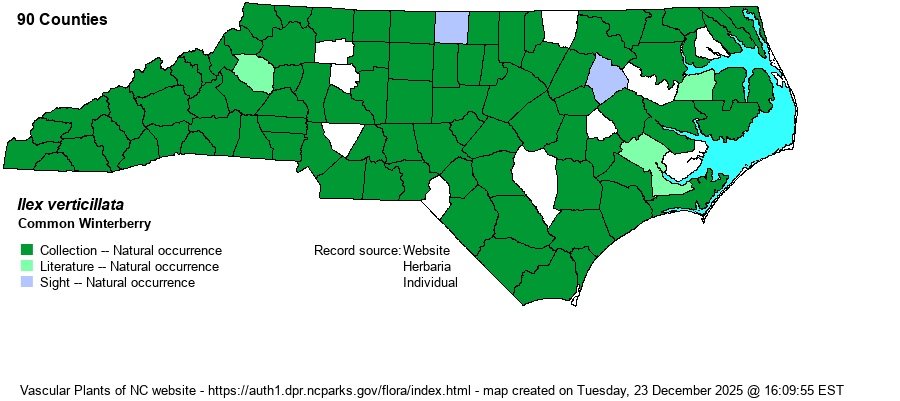| Author | (L.) A. Gray | |
| Distribution | Nearly statewide, but scarce in parts of the lower Coastal Plain. Occurs in most all Mountain and Piedmont counties.
This is a species of the eastern U.S. and southeastern Canada, occurring south to the FL Panhandle, and west to eastern TX.
| |
| Abundance | Despite a number of counties without known documentation, it is generally common (at least locally) in the Mountains, Piedmont, and eastward to the western Coastal Plain. Fairly common in most of the remainder of the Coastal Plain, except very rare or absent in the far eastern counties. Also seemingly quite scarce in parts of the central-southern Coastal Plain, including the Sandhills region. | |
| Habitat | This is a strictly wetland species, generally in moderately rich to slightly acidic soils. It favors floodplain pools and seepages, swamps, and wet thickets. It also occurs in bogs, some streamhead pocosins, and other types of pocosins, but in these acidic wetlands it is not one of the more numerous shrubs. |
| Phenology | Blooms in April and May, and fruits from September to November, remaining into midwinter. | |
| Identification | This is one of the “ordinary-looking” deciduous shrubs with elliptic, alternate leaves, growing to about 10 feet tall. The leaves are dull above, serrate along the margins, and average about 2-2.5 inches long. It can be somewhat tricky to identify without fruit, but in late summer and fall the numerous red “berries” should clinch the identification, as there are relatively few such red-fruited shrubs growing in standing water in shaded wetlands. The somewhat similar I. laevigata grows in more acidic wetlands, especially pocosins, and has shiny leaves with larger scarlet fruit. Other hollies such as I. ambigua, I. montana, and I. longipes have similar elliptical leaves and red fruit, but these seldom grow in standing water of pools, seepages, and swamps. | |
| Taxonomic Comments | There have been a few varieties named from time to time, but most recent references do not accept these.
| |
| Other Common Name(s) | Often called simply “Winterberry”, but as the similar I. laevigata is known widely as Smooth Winterberry, calling this species simply as “Winterberry” is not suitable. Thankfully, some references responsibly use a modifier name, as Common Winterberry. | |
| State Rank | S5 | |
| Global Rank | G5 | |
| State Status | | |
| US Status | | |
| USACE-agcp | FACW link |
| USACE-emp | FACW link |

